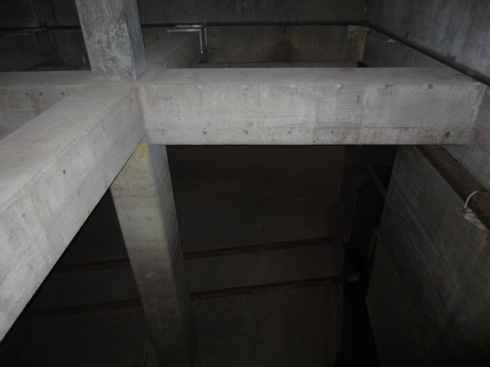
22 Cambridgeport residents, CWRA and Mystic Watershed staff and MIT students toured the Cottage Farm Facility last Thursday night.
MWRA Executive Director Fred Laskey and Director of Wastewater Operations and Maintenance Stephen Cullen led us to the underworld of Magazine Beach last night with a tour of the Cottage Farm Combined Sewer Overflow (CSO) Treatment Plant. Who would have known that we had modern Roman catacombs/cisterns (only with a wastewater focus) just down that street? In what appears to be a compact brick building, lies room after room of engines, pumps, screening mechanisms, and stormwater holding areas, all designed to prevent a mixture of sewage and stormwater from flowing into the Charles.
In much of Boston, Cambridge, there is just one sewer pipe running down each street that is used for both the sanitary sewage from our houses and storm water from the street drains. This is a combined sewer/storm water system. Other towns have two sewer pipes on each street, one for sewage, the other for storm water. Storm water flows can increase dramatically during a heavy rainstorm. That happened in Cambridgeport in June of 2011 when 3 inches of rain fell in about 15 minutes, sending diluted sewage into a number of basements in the neighborhood. In a two pipe system, the same thing could happen with the stormwater pipe, but the backup in our basements would be sewage free.
Built in the late 1960’s and brought on line in 1971, Cottage Farm is a Combined Sewer Overflow Treatment facility. It is designed to manage both sanitary waste (poop, etc.) and surface run-off from storms that arrives at the facility in two pipes—one from the North and another from the West. Normally it then funnels under the Charles River to the Ward Street Headworks (near the MFA and Wentworth Institute) and then is pumped to Deer Island to be processed and released in the ocean—nine miles out.
During storms the flow can exceed the capacity of the very large pipes. In the old days the excess flow was diverted into the Charles. Now, up to 1.3 million gallons can be stored in the detention tanks in the Cottage Farm CSO facility. It is pumped back into the pipes and on to Deer Island once the flows have gotten back to more normal levels. Discharges to the Charles River occur only if the capacity of the detention tanks is exceeded.
As the sewage comes into the plant it goes through a series of screens. The first screen catches the big stuff–would you believe tires and 2×4’s? Leaves are a big problem for a few weeks in October. The smallest screen before water ends up in the Charles is a half of an inch. The waste is chlorinated like a swimming pool to kill pathogens, and de-chlorinated to protect the aquatic life in the river before overflowing into the Charles.

After screening, chlorinating and de-chlorinating, some treated wastewater is discharged to the Charles River. Note the “man catcher” screen.
Preparing for climate change is a priority for the MWRA. The systems at Deer Island—the 2nd largest sewage treatment plant in the USA—were built elevated, in case the ocean rose. We were assured that Cottage Farm will operate whether or not there is flooding and electric power. They have emergency generators there and can run it remotely from Chelsea or a backup facility in Marlborough. Laskey proudly noted that the MWRA has one of the best water storage systems in the country. It is considered a model. I certainly felt reassured knowing that Laskey and Cullen were in charge—both are knowledgeable, passionate and committed to preserving our water quality.

The MWRA is responsible for providing clean water for over 61 communities in the greater Boston area.
Note: The MWRA was established by an act of the Legislature in 1984 to provide wholesale water and sewer services to 2.5 million people and more than 5,500 large industrial users in 61 metropolitan Boston communities and to comply with the Clean Water Act. The agency has cleaned up the Boston Harbor and modernized the region’s water systems.
For further info, see: http://www.mwra.state.ma.us/index.html
For a short history of our sewage system, see: http://www.mwra.state.ma.us/03sewer/html/sewhist.htm
For an illustration of a CSO, see: http://www.cityofbremerton.com/content/cso_csos.html
Many thanks to Stephen Cullen, Sarah Satterthwaite and Royce Buehler for their contributions to this post!








Leave a comment